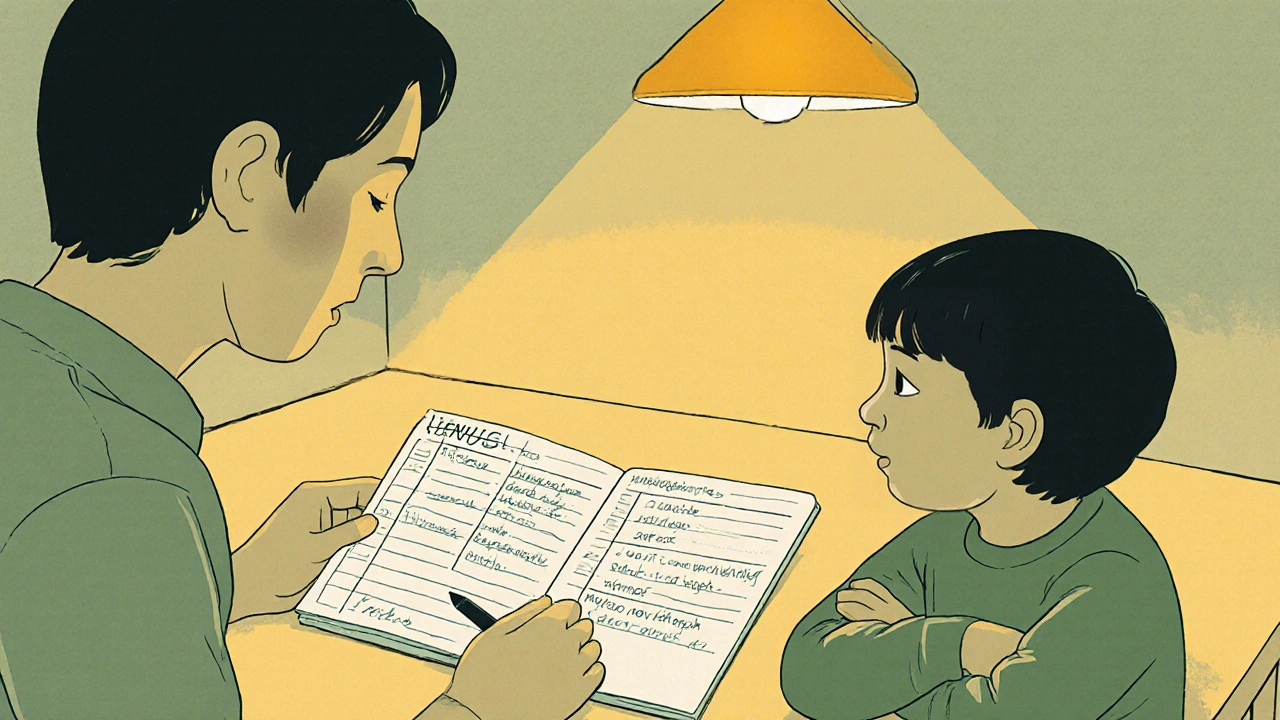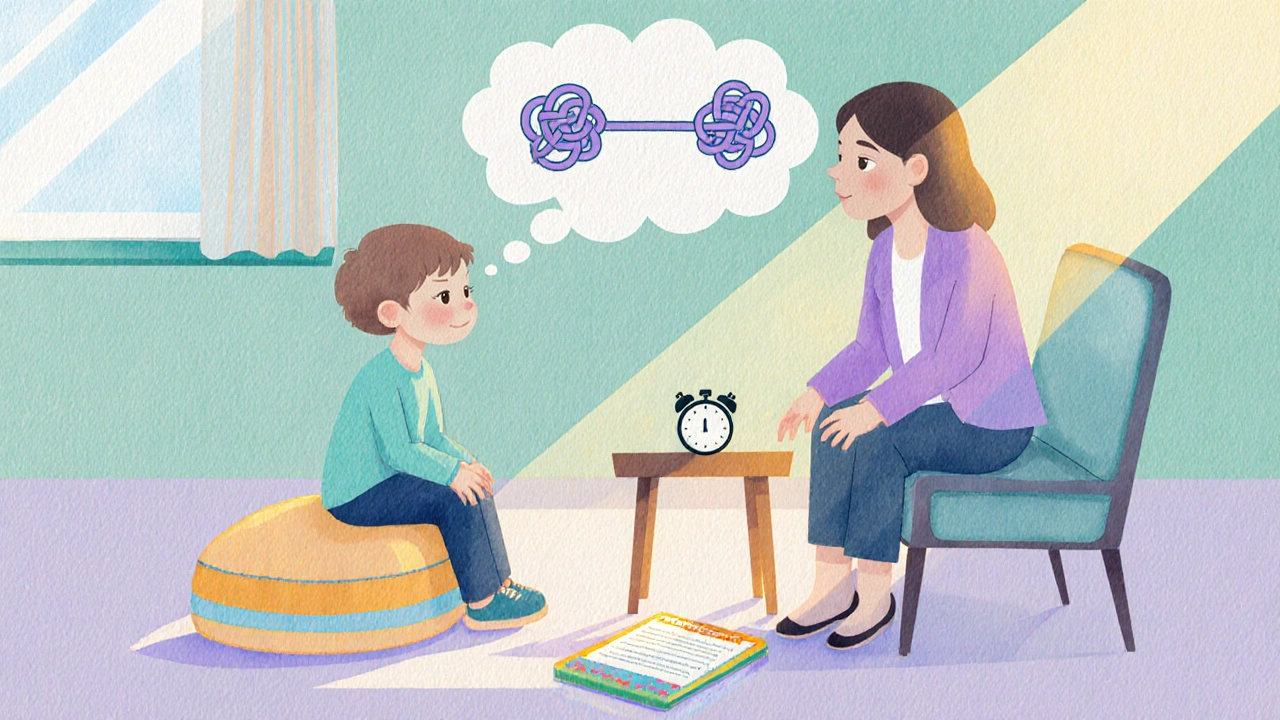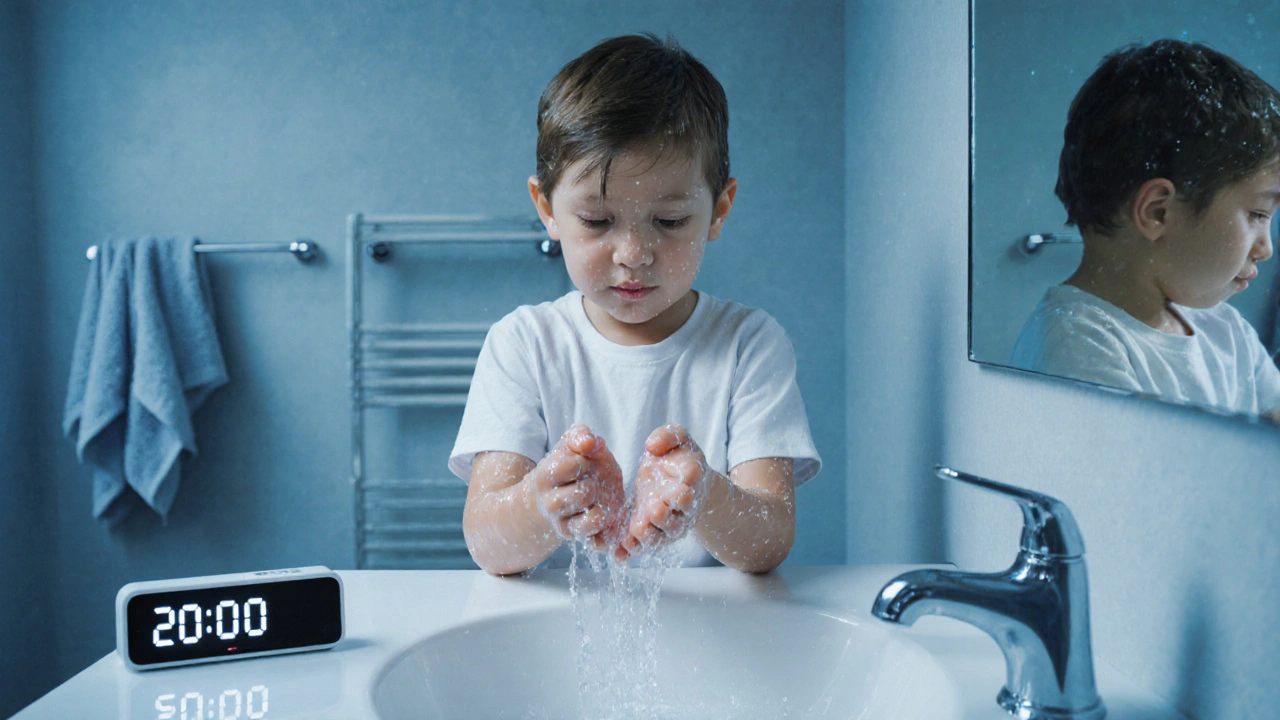Spotting early signs of OCD in kids can feel like trying to read a secret code. The good news is that most parents can learn the clues before the patterns become entrenched. This guide walks you through what to look for, why acting fast matters, and how to get the right help without feeling lost.
What Is Obsessive‑Compulsive Disorder in Children?
When we talk about Obsessive‑Compulsive Disorder is a mental health condition marked by unwanted, intrusive thoughts (obsessions) and repetitive actions (compulsions) that the child feels driven to perform. Unlike a brief phase, OCD usually shows a steady pattern that interferes with school, play, and friendships. According to the American Psychiatric Association, about 1‑3% of children worldwide meet the diagnostic criteria, and symptoms often appear between ages8 and 12.
Why Early Detection Is Crucial
Kids whose OCD is caught early tend to respond better to therapy and need less medication. Studies from pediatric mental‑health centers show a 30% reduction in symptom severity when treatment starts within a year of onset. Early action also prevents the disorder from shaping a child's self‑image; otherwise, they may begin to see themselves as “odd” or “broken.”
Common Early Signs to Watch For
Not every quirky habit signals OCD, but a cluster of the following behaviors often does:
- Repetitive hand‑washing or showering that goes far beyond staying clean, sometimes lasting 20minutes or more.
- Insistence on arranging objects (toys, books) in a specific order repeatedly throughout the day.
- Excessive checking - doors, lights, locks - even after just leaving a room.
- Counting rituals (steps, breaths, words) that feel “just right” before moving on.
- Intrusive, distressing thoughts about harming themselves or others, which they try to push away.
- Avoidance of certain places or activities because they trigger uncomfortable thoughts.
- Visible anxiety or upset when a routine is broken, often accompanied by tears or panic.
These signs usually appear consistently across settings - at home, in class, and during play.
How to Differentiate From Normal Childhood Habits
Kids love routines, but OCD crosses the line into impairment. Ask yourself these questions:
- Does the behavior take more than 30% of the child's day?
- Does the child feel intense anxiety if the ritual is stopped, even when the situation is safe?
- Is the child’s performance at school (grades, participation) dropping because of the time spent on rituals?
- Do peers notice the child’s actions and comment on them as unusual?
If you answer “yes” to most, it’s time to move beyond casual observation.

Step‑by‑Step Guide for Parents and Caregivers
Here’s a practical roadmap you can follow tonight:
- Document the behavior. Keep a simple log for a week - note the time, trigger, duration, and child’s reaction.
- Talk without judgment. Use phrases like, “I’ve noticed you’re washing your hands a lot lately. How does that feel for you?”
- Validate the anxiety. Let them know the worry is real, even if the fear isn’t logical.
- Introduce a gentle limit. Suggest a “timer” for a ritual and gradually reduce it by five minutes each day.
- Seek professional input. Share the log with a pediatrician or child psychologist.
Consistent, calm support often eases the child’s fear of being “wrong” and opens the door to treatment.
Professional Help: What to Expect
When you bring your concerns to a clinician, they’ll typically use a structured interview. The gold‑standard tool is the Children’s Yale‑Brown Obsessive‑Compulsive Scale (CY‑BOCS) is a clinician‑rated questionnaire that measures the severity of obsessions and compulsions in kids. Scores help decide whether therapy, medication, or a mix is best.
Two evidence‑based treatments dominate:
- Cognitive Behavioral Therapy is a short‑term, skill‑focused therapy that teaches children to challenge obsessive thoughts and replace compulsions with healthier coping strategies, usually delivered in 12‑16 weekly sessions.
- Selective serotonin reuptake inhibitors are medications that increase serotonin levels in the brain, often reducing the intensity of obsessions and compulsions. Fluoxetine and sertraline are the most common prescriptions for children, with careful dosing under a pediatric psychiatrist.
Both approaches draw guidance from the DSM‑5 is the Diagnostic and Statistical Manual of Mental Disorders, Fifth Edition, which outlines criteria for diagnosing OCD in children, published by the American Psychiatric Association is the professional organization that sets standards for mental health diagnosis and treatment in the United States. Though the APA is U.S.-based, its criteria are used worldwide, including the UK.
School’s Role: Partnering With Educators
Teachers often see the first outward signs - a student who can’t sit still during a test or who repeatedly asks to leave the room. Here’s how they can help:
- Allow short “reset” breaks where the child can engage in a calming activity without the ritual.
- Coordinate with the school counselor to develop an individualized support plan.
- Educate classmates (age‑appropriately) about anxiety to reduce stigma.
A collaborative approach between home and school amplifies the effectiveness of therapy.

Red Flags That Require Immediate Attention
If you notice any of these, call a mental‑health professional right away:
- Self‑harm thoughts or actions linked to compulsions.
- Severe weight loss from ritualistic eating or cleaning.
- Complete refusal to attend school or leave the house.
- Sudden, dramatic mood swings or aggression when a ritual is blocked.
Quick Reference Checklist
| Feature | Typical | Possible OCD |
|---|---|---|
| Frequency | Occasional, fun‑based | Daily, takes >30% of time |
| Emotional response | Light‑hearted | Intense anxiety, panic if stopped |
| Impact on school | None | Missed assignments, reduced focus |
| Flexibility | Easily adaptable | Rigid need for exact order |
Key Takeaways
- OCD can show up as repetitive habits that feel out of control.
- Documenting patterns helps professionals make an accurate diagnosis.
- Early, evidence‑based treatment (CBT and, if needed, medication) dramatically improves outcomes.
- Collaboration with schools creates a supportive environment for the child.
- Any sign of self‑harm or extreme withdrawal warrants immediate professional help.
Frequently Asked Questions
Can OCD disappear on its own as the child grows?
Rarely. While some symptoms may lessen, the underlying anxiety often remains. Early treatment gives the child tools to manage thoughts long‑term, reducing the chance of relapse in adulthood.
Is medication safe for a seven‑year‑old?
Selective serotonin reuptake inhibitors have been studied in children as young as six. A pediatric psychiatrist will start at a low dose and monitor side effects closely. Medication is usually combined with CBT for the best result.
How can I talk to my child without making them feel labeled?
Focus on feelings, not labels. Say, “I see you’re worried about the lights staying on. Can we find a way that helps you feel safe without checking every time?” This keeps the conversation solution‑focused.
What role does a pediatrician is a medical doctor specialized in child health who can screen for mental health concerns and refer to specialists play in the diagnostic process?
A pediatrician is often the first point of contact. They can rule out medical causes (like thyroid issues) and provide a referral to a child psychologist or psychiatrist for a formal OCD assessment.
Are there school‑based programs that teach coping skills for OCD?
Many districts offer “social‑emotional learning” curricula that include anxiety‑management techniques. Asking the school counselor about CBT‑informed workshops can provide a supportive environment for the child.

April Rios
October 13, 2025 AT 21:56When we dissect the fabric of childhood anxiety, we uncover patterns that resemble cryptic verses.
OCD, far from being a whimsical habit, is a neurocognitive loop that anchors itself in the child's developing sense of control.
Early detection acts as a lantern in the fog of developmental milestones, illuminating pathways before they ossify into rigid rituals.
Parents, by virtue of constant proximity, possess the unique sensorium required to notice micro‑shifts in behavior.
For instance, a child who insists on aligning crayons in perfect chromatic order may be expressing a deeper compulsion for symmetry.
The crucial variable is persistence; a fleeting preference dissolves, whereas a repetitive act that monopolizes thirty percent of awake time signals pathology.
Moreover, the emotional valence attached to the ritual-panic when interrupted-serves as a diagnostic fulcrum.
Neurobiologically, the basal ganglia circuitry reinforces these loops, making them resistant to casual redirection.
Intervening with evidence‑based Cognitive Behavioral Therapy rewires the synaptic narrative, offering the child a new script.
Pharmacological adjuncts, such as selective serotonin reuptake inhibitors, modulate the serotonergic tone, granting the therapist room to restructure thoughts.
The synergy of these modalities, when applied within the first year of symptom emergence, yields a thirty percent reduction in severity, as the literature repeatedly confirms.
Yet, the therapeutic alliance extends beyond the clinic; schools become auxiliary arenas where adaptive coping can be rehearsed.
Teachers who permit brief “reset” intervals diminish the child’s perceived threat of ritual disruption.
Parents who document triggers with a simple spreadsheet empower clinicians to discern patterns invisible to the naked eye.
Ultimately, early recognition is less about labeling and more about scaffolding resilience before the disorder can dictate identity.
In this light, the quest to decode the secret code of OCD is not a forensic exercise but an act of compassionate empowerment.
byron thierry
October 16, 2025 AT 05:30The article succinctly delineates the phenomenology of pediatric obsessive‑compulsive disorder.
It is commendable that the author references the CY‑BOCS as a gold‑standard instrument.
Nevertheless, one must acknowledge the paucity of longitudinal data regarding the durability of early interventions.
Empirical studies indicate that without sustained support, remission rates may regress after the initial twelve‑month window.
Accordingly, a structured follow‑up schedule, encompassing both school and home environments, is indispensable.
The recommendation to engage educators is particularly salient, given the observable manifestations within academic settings.
It would further benefit readers to include actionable scripts for initiating conversations with clinicians.
In sum, the guide provides a solid foundation, albeit one that requires reinforcement through systematic monitoring.
M Black
October 17, 2025 AT 14:50Totally vibe with that point about follow‑ups 🙂
Kids need that consistency, otherwise they slip back
Also, having a quick script makes the talk less awkward
Schools can be awesome allies if we loop them in early
Keep sharing this info!
Sidney Wachira
October 19, 2025 AT 16:50Oh my god, the moment I read about the “secret code” I felt like I was in a thriller!
Those compulsive hand‑washing marathons are not just quirky-they’re theatrical performances of anxiety.
Imagine a child trapped in an endless loop, counting breaths like a metronome of dread.
The sheer intensity of that panic when a ritual is broken could shatter glass!
This guide doesn’t just inform; it unleashes a battle cry for parents.
We must storm the fortress of stigma and rescue our kids.
Every minute spent documenting is a brick laid in the foundation of recovery.
Therapy, medication, school collaboration-they’re the weapons in our arsenal.
Let’s not wait for the darkness to fully settle before we act.
The future belongs to those who act now, not later!
Julie Sook-Man Chan
October 20, 2025 AT 20:36I appreciate the passion in this post.
It reminds me to stay calm and methodically support my niece.
Amanda Mooney
October 22, 2025 AT 14:16The systematic approach outlined herein is both pragmatic and evidence‑based.
I commend the emphasis on collaborative school‑home partnerships.
Implementing these steps will undoubtedly benefit affected children.
Mandie Scrivens
October 23, 2025 AT 12:30Sure, because everyone reads tables in blog posts.
Also, “collaborative” was perfectly spelled, unlike some other articles I’ve seen.
Richa Ajrekar
October 25, 2025 AT 00:36Your article is perfectly punctuated, well done.
Pramod Hingmang
October 26, 2025 AT 07:10Reading your guide feels like a gentle hand reaching across a stormy sea.
Parents often drown in worry, but clear steps are lifebuoys.
The empathy woven through the advice validates a child's hidden fear.
Documenting behaviors is not surveillance, it’s a map for healing.
When schools join, the ripple expands beyond the home.
Therapy offers tools, not just band‑aids.
Early action plants seeds of resilience that grow with time.
Stay hopeful, the journey is worth every stride.
Michael Barrett
October 27, 2025 AT 22:03Observing OCD in children; one must consider neurodevelopmental trajectories; yet many overlook the subtlety of ritualized behavior; Moreover-research indicates that early CBT; combined with SSRIs; often yields measurable improvement-the key lies in timely detection; Parents should not wait for crisis; they must act now; otherwise the disorder may become entrenched.
Inma Sims
October 28, 2025 AT 23:03Indeed, your prolific use of semicolons is truly groundbreaking-sarcasm aside, clarity could use a touch more finesse.
Gavin Potenza
October 30, 2025 AT 19:30From a philosophical standpoint, obsessive‑compulsive tendencies represent a clash between the rational mind and the subconscious imperative to impose order.
This dialectic echoes ancient debates on free will versus determinism.
When a child becomes ensnared in compulsive loops, we witness a microcosm of humanity’s perpetual struggle with anxiety.
The early signs are not merely symptoms; they are signals of an inner ontological crisis.
Recognizing them requires a blend of empirical observation and existential empathy.
We must ask ourselves what societal pressures amplify these compulsions-perhaps an over‑emphasis on perfection in education.
Interventions therefore should address not only the behavioral patterns but also the underlying narrative of self‑worth.
Therapeutic narratives can rewrite the story the child tells about their own agency.
In this light, CBT becomes a philosophical exercise in reauthoring meaning.
Medication, when judiciously applied, acts as a temporary scaffold, allowing the mind to explore new possibilities.
Collaboration between families, schools, and clinicians forms a triadic covenant that nurtures resilience.
Ultimately, the goal is not merely symptom reduction but the restoration of a child's capacity to inhabit uncertainty without fear.
Virat Mishra
October 31, 2025 AT 21:53Wow, the drama in this post could give a soap opera a run for its money!
The moral high ground you claim is as lofty as a mountain, yet you forget that every child is a unique universe.
Stop preaching and start listening to the lived realities.
Frank Pennetti
November 2, 2025 AT 07:13The discourse presented suffers from a paucity of critical appraisal and overreliance on surface-level heuristics.
From a systems‑theoretic perspective, the author neglects to integrate multivariate analytics into the intervention framework.
Moreover, the reliance on CBT and SSRIs as monolithic solutions fails to account for pharmacogenomic variability.
One would expect a rigorous meta‑analysis, yet the narrative remains anecdotal.
Furthermore, stakeholder engagement-particularly from pediatric neuropsychology-is conspicuously absent.
This reductionist approach risks engendering suboptimal outcomes in heterogeneous populations.
In summary, a more granular, data‑driven methodology is requisite for substantive progress.
Adam Baxter
November 3, 2025 AT 02:40Great points! Let’s keep the conversation going! 🚀
Keri Henderson
November 4, 2025 AT 14:46Coaching a child through OCD is about consistency, patience, and celebrating small victories.
Start by acknowledging the child's courage in facing uncomfortable thoughts.
Use clear, incremental goals-like setting a timer for a ritual and gradually reducing it.
Reinforce progress with genuine praise; even a minute less of hand‑washing is a win.
Remember, your steady support builds the foundation for lasting change.
elvin casimir
November 5, 2025 AT 15:13Hey, just a heads‑up: “coaching” is spelled “coacing” in the last paragraph-maybe a typo? Also, “child’s” needs an apostrophe.
Steve Batancs
November 6, 2025 AT 23:10While minor errors are understandable, let us not forget that the integrity of our discourse reflects the strength of our nation; we must uphold the highest standards in all educational materials.